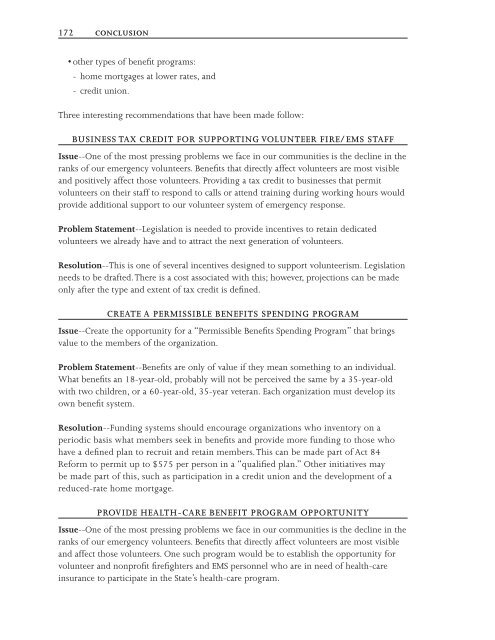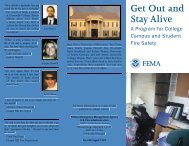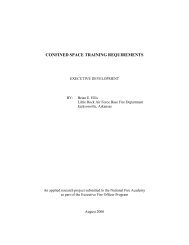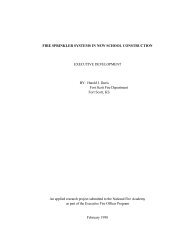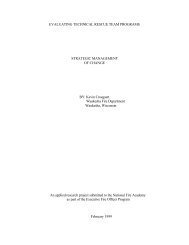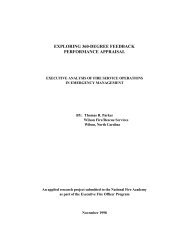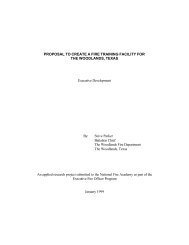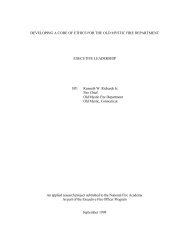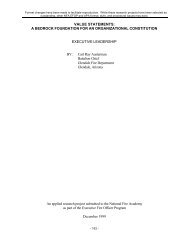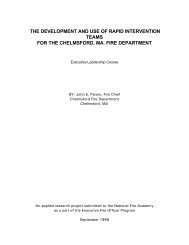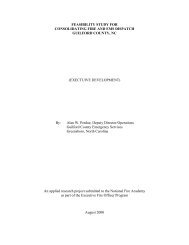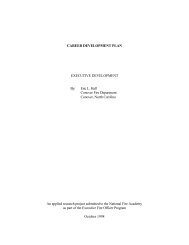Retention and Recruitment for the Volunteer Emergency Services
Retention and Recruitment for the Volunteer Emergency Services
Retention and Recruitment for the Volunteer Emergency Services
You also want an ePaper? Increase the reach of your titles
YUMPU automatically turns print PDFs into web optimized ePapers that Google loves.
7 conclusion<br />
• o<strong>the</strong>r types of benefit programs:<br />
- home mortgages at lower rates, <strong>and</strong><br />
- credit union.<br />
Three interesting recommendations that have been made follow:<br />
BuSINESS TAx CREDIT FOR SuPPORTINg VOLuNTEER FIRE/EMS STAFF<br />
issue--One of <strong>the</strong> most pressing problems we face in our communities is <strong>the</strong> decline in <strong>the</strong><br />
ranks of our emergency volunteers. Benefits that directly affect volunteers are most visible<br />
<strong>and</strong> positively affect those volunteers. Providing a tax credit to businesses that permit<br />
volunteers on <strong>the</strong>ir staff to respond to calls or attend training during working hours would<br />
provide additional support to our volunteer system of emergency response.<br />
Problem statement--Legislation is needed to provide incentives to retain dedicated<br />
volunteers we already have <strong>and</strong> to attract <strong>the</strong> next generation of volunteers.<br />
resolution--This is one of several incentives designed to support volunteerism. Legislation<br />
needs to be drafted. There is a cost associated with this; however, projections can be made<br />
only after <strong>the</strong> type <strong>and</strong> extent of tax credit is defined.<br />
CREATE A PERMISSIBLE BENEFITS SPENDINg PROgRAM<br />
issue--Create <strong>the</strong> opportunity <strong>for</strong> a “Permissible Benefits Spending Program” that brings<br />
value to <strong>the</strong> members of <strong>the</strong> organization.<br />
Problem statement--Benefits are only of value if <strong>the</strong>y mean something to an individual.<br />
What benefits an 18-year-old, probably will not be perceived <strong>the</strong> same by a 35-year-old<br />
with two children, or a 60-year-old, 35-year veteran. Each organization must develop its<br />
own benefit system.<br />
resolution--Funding systems should encourage organizations who inventory on a<br />
periodic basis what members seek in benefits <strong>and</strong> provide more funding to those who<br />
have a defined plan to recruit <strong>and</strong> retain members. This can be made part of Act 84<br />
Re<strong>for</strong>m to permit up to $575 per person in a “qualified plan.” O<strong>the</strong>r initiatives may<br />
be made part of this, such as participation in a credit union <strong>and</strong> <strong>the</strong> development of a<br />
reduced-rate home mortgage.<br />
PROVIDE HEALTH-CARE BENEFIT PROgRAM OPPORTuNITy<br />
issue--One of <strong>the</strong> most pressing problems we face in our communities is <strong>the</strong> decline in <strong>the</strong><br />
ranks of our emergency volunteers. Benefits that directly affect volunteers are most visible<br />
<strong>and</strong> affect those volunteers. One such program would be to establish <strong>the</strong> opportunity <strong>for</strong><br />
volunteer <strong>and</strong> nonprofit firefighters <strong>and</strong> EMS personnel who are in need of health-care<br />
insurance to participate in <strong>the</strong> State’s health-care program.


